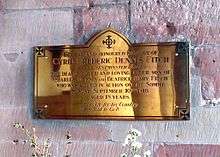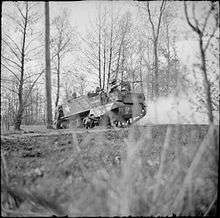Queen's Westminsters
The Queen's Westminsters was an infantry regiment of the Territorial Army, part of the British Army.
History

The regiment was formed on 31 December 1921 as the 16th (County of London) Battalion (Queen's Westminster and Civil Service Rifles), London Regiment by the amalgamation of the 15th (County of London) Battalion (Prince of Wales's Own Civil Service Rifles), London Regiment and the 16th (County of London) Battalion (Queen's Westminster Rifles), London Regiment. The Queen's Westminster Rifles had been formed in the late 19th century, in honour of Queen Victoria, and was by 1902 the largest volunteer rifle corps in London.[1]
In 1922, it became the 16th London Regiment (Queen's Westminster and Civil Service Rifles). In 1937, it was transferred to the King's Royal Rifle Corps, being renamed as the Queen's Westminsters.
Second World War
On 3 September 1939—two days after Nazi Germany had launched its invasion of Poland—the British Empire, France, and their Allies declared war on Germany, beginning World War II.
The original Westminsters became the 1st Battalion after a duplicate battalion was raised in 1939. The following year, it was converted to a motor battalion. In 1941, the 1st Battalion was re-titled as the 11th (Queen's Westminsters) Battalion, King's Royal Rifle Corps, and the 2nd, the 12th (Queen's Westminsters) Battalion, King's Royal Rifle Corps.
The Westminsters saw extensive service during the war. The 11th Westminsters, as part of the 24th Armoured Brigade, saw service in the North African Campaign in mid-1942, taking part in the Allied offensive during the Second Battle of El Alamein against Erwin Rommel's Afrika Korps; it was the first major Allied victory against Germany on land, and the British Prime Minister, Winston Churchill, summed up the importance of the battle with the words '"now this is not the end, it is not even the beginning of the end. But it is, perhaps, the end of the beginning." The battalion took part in the subsequent advance after the Germans and Italians went into full-retreat in North Africa, seeing action in the Tunisia Campaign as part of the 23rd Armoured Brigade after the 24th Armoured Brigade was disbanded.
The 11th Westminsters moved to Sicily the following year, taking part in the campaign on the Italian island, which began on 10 July 1943. It later moved to the Italian Front, remaining there into 1944. In December 1944, the Westminsters took part in the operations to quell a Communist uprising in the Greek capital of Athens; this mission was successful and a cease-fire was signed on 11 January 1945.

The 12th Westminsters, having remained in the United Kingdom since the war began, took part in the Battle of Normandy in 1944, forming part of the 8th Armoured Brigade. It saw extensive service in France, including action at Rauray on 26 June and at Mont Pincon in Operation Epsom and during the advance east to the Seine, which was crossed in late August. The battalion subsequently crossed the Somme river, a scene of carnage during the Great War, which the Westminsters predecessors had experienced. It later took part in the liberation of Lille in early September, experiencing a welcoming reception by the inhabitants of the large town. Shortly afterwards, the 12th took part in the advance into Belgium, taking part in, among others, the capture of Oostham. The 12th Westminsters saw further service in the Netherlands and when Victory in Europe Day came on 8 May, were in Germany itself.
Notable soldiers in the Westminsters during World War II include the journalist Bill Deedes, who served in the North West Europe Campaign, and was awarded the Military Cross, and Lord Killanin, the former President of the International Olympic Committee.
Post-War
Shortly after the war, the Territorial Army was reconstituted and the 11th and 12th amalgamated to form, simply, The Queen's Westminsters. On 1 May 1961, it was amalgamated with the Queen Victoria's Rifles to form the Queen's Royal Rifles.
Other information
- Honorary Colonels:
Battle honours
- Second World War:
- North-West Europe: Mont Pincon, Roer, Rhineland, Kleve, Goch, Rhine, North-West Europe 1944-45
- North Africa: El Alamein, North Africa 1942
- Italy: Italy 1943-44
- Other: Athens, Greece 1944-45
References
- ↑ "Naval & Military intelligence". The Times (36801). London. 23 June 1902. p. 6.
External links
![]() Media related to Queen's Westminsters at Wikimedia Commons
Media related to Queen's Westminsters at Wikimedia Commons